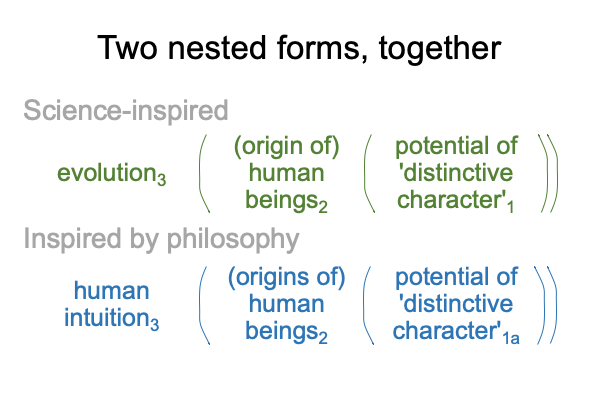0009 The last sentence of Turbon’s abstract presents the crux, the point and the inspiration for the entire article. Two category-based nested forms stand side by side. The question now becomes, “Do these normal contexts exclude, complement or align?”
0010 Here they are.

0011 They look like the same cards of different suites, say clubs and hearts.
Can clubs exclude hearts?
0012 Clearly, Turbon does not publish an essay in the journal, Scientia et Fides, in order to support exclusion. Exclusion is already in the cards. The deck is stacked. Science excludes human intuition.
Why is this so?
0013 One reason is formulated in Comments on Jacques Maritain’s Book (1935) Natural Philosophy. Scientific judgment relies on the positivist intellect. The positivist intellect rules out metaphysics. What is the advantage? The rule assists in distinguishing a noumenon from its phenomena. Phenomena are subject to empirio-schematic judgments. Their noumenon is not.
0014 Science measures, models and discusses phenomena, the observable facets of a thing.
Philosophy guides inquiry into the thing itself, the noumenon.
Consequently, a noumenon cannot be objectified as its phenomena.
Yet, a noumenon is necessary for phenomena to exist.
0015 So, exclusion is not in the cards. What about complement?
Clubs and hearts are suites with similar cards. They complement one another. They exist in the same deck. But, if clubs are like science and hearts are like philosophy, and if science focuses on phenomena and philosophy explores their noumenon, then what about the contiguity?
The contiguity between a noumenon and its phenomena is “cannot be objectified as”.
Clubs cannot be objectified as hearts.
Philosophy cannot be objectified as science.
Is this what Turbon aims to tell the reader?
I don’t think so.
0016 Intuition3 and evolution3 cannot exclude or complement one another. So, they must align.
This is Turbon’s deal.
